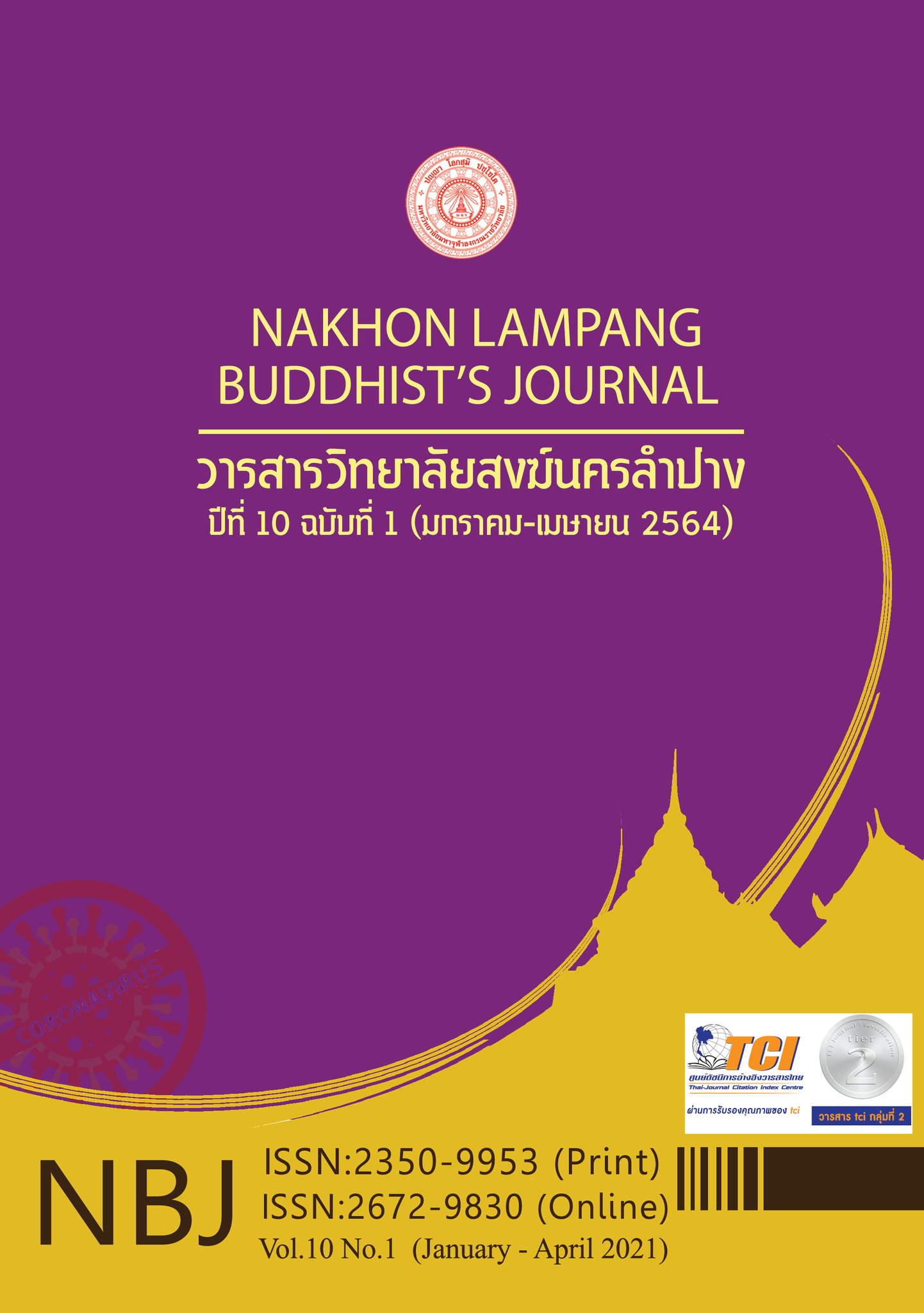A PATTERN FOR ENHANCING BUDDHIST WELL-BEING OF THE TAMBON PEOPLE’S TRAINING UNITIN THE NORTH OF THAILAND
Main Article Content
Abstract
Research studies Model for enhancing Buddhist well-being Of the district people training unit (Or Soror) in the North with the objective To develop the body of knowledge and media to promote well-being according to Buddhism of the sub-district people training unit in the North To develop the Buddhist well-being innovation of the Tambon People's Training Unit And to build cooperation networks of government agencies, the private sector and civil society With the working mechanism of the Tambon People's Training Unit, the researcher used the qualitative research model (Action Research) by integrating Buddhist concepts with modern science and local wisdom. The development of the role of the Sangha In enhancing the Buddhist well-being of the Tambon Boromma District The study found that Driving the work of the district training unit in the north Consistent with the policy of the Sangha and the 8 important missions: morality and culture Health and Sanitation of Livelihood Peace Education Welfare Public welfare Gratitude, Gratitude, Dharma, fellowship by integrating with the village driving project, keeping the 5 precepts and the reform of the Sangha Affairs It is a method of applying Buddhist principles in promoting health and sustainability. Important principles that can be applied, such as the Tri-Sikha, Prayana 4, etc., which integrate principles to enhance health. It can be seen that the operation of the PTTEP unit is based on the supportive work of the local government organization and the government sector, its performance reflects the stakeholders of the project and activities. Including the district people training unit Performance reflects the stakeholders of the project and activities. Reform of the Sangha Affairs Driving villages to maintain the 5 precepts, communities, local government organizations Government and private sectors, educational institutions Under the leadership of working tools, including meetings, SWOT analysis, AIC techniques, group discussions, information, learning centers. And workshops Making the project-driven operation a success Which factors for success include social capital, participation Creating a leader for the monks and communities Network building And direct, follow, adjust strategies that stay flexible And still found obstacles in the work, such as the time to drive continuously, information on the performance leading to the advocacy of the policy, such as the policy of promoting the district people training unit Local government policies And the development of public training units for the civil state For further enhancement of Buddhist well-being.
Article Details
References
เกรียงศักดิ์ เจริญวงศ์ศักดิ์. การจัดการเครือข่าย: กลยุทธ์สาคัญสู่ความสำเร็จของการปฏิรูปการศึกษา. กรุงเทพมหานคร. บริษัท ซัคเซสมีเดีย จากัด, 2543.
คณะกรรมการประสานงานแผนยุทธศาสตร์ในการปฏิรูปกิจการพระพุทธศาสนา (คปพ.). รายงานสรุปการขับเคลื่อนแผนปฏิรูปกิจการพระพุทธศาสนา, 2561.
ฉลาด จันทรสมบัติ. การมีส่วนร่วมของชุมชนในการจัดการศึกษาเพื่อพัฒนาท้องถิ่น. วารสารการบริหารและพัฒนา. ปีที่ 2 ฉบับที่ 1 มกราคม – เมษายน 2553.
ติน ปรัญพฤทธิ์. ทฤษฎีองค์การ. กรุงเทพมหานคร. ไทยวัฒนาพานิช, 2538.
ถวิลวดี บุรีกุล. พลวัตการมีส่วนร่วมของประชาชน : จากอดีตจนถึงรัฐธรรมนูญแห่งราชอาณาจักรไทย พุทธศักราช 2550.กรุงเทพมหานคร. บริษัท เอ.พี. กราฟิค ดีไซน์และการพิมพ์ จากัด, 2552.
ประเวศ วะสี, สุขภาวะชุมชนเป็นรากฐานของสุขภาวะทั้งมวล, กรุงเทพมหานคร. บริษัท พ.เอ. ลีฟวิ่ง จากัด, 2554.
ปาริชาติ วลัยเสถียร. กระบวนการและเทคนิคการทางานของนักพัฒนา. กรุงเทพมหานคร. สานักกองกลางการสนับสนุนการวิจัย, 2542.
พระครรชิต คุณวโร ชูฤทธิ์ เต็งไตรสรณ์ และ อรุณีวชิราพรทิพย์. “การพัฒนาแบบวัดสุขภาวะองค์รวมแนวพุทธ. วารสารวิชาการสาธารณสุข, 2555.
พระพรหมคุณาภรณ์ (ป.อ. ปยุตฺโต). อ้างใน พระครรชิต คุณวโร ชูฤทธิ์ เต็งไตรสรณ์ และ อรุณีวชิราพรทิพย์, “การพัฒนาแบบวัดสุขภาวะองค์รวมแนวพุทธ. วารสารวิชาการสาธารณสุข. ปีที่ 17 ฉบับเพิ่มเติม 6 (กันยายน – ตุลาคม 2551).
พระมหาบุญเลิศ ช่วยธานี. คู่มือขับเคลื่อนโครงการสังฆพัฒนาวิชชาลัย. กรุงเทพมหานคร. จรัลสนิทวงศ์การพิมพ์, 2560.

